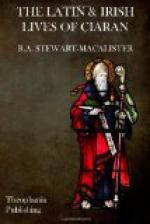One of the numerous tales told of the danger of crossing the will of a saint. It is possibly suggested by Matt, xxi, 28; but it may also be a pre-Christian folk-tale adapted to the new Faith by substituting a saint for a druid. On the cursing propensities of Irish saints see Plummer, VSH, i, pp. cxxxv, clxxiii. A curse said to have been pronounced by Ciaran on one family remained effective down to the year 1151, where it is recorded by the Annals of the Four Masters (vol. ii, p. 1096). Another curse of the same saint, and its fulfilment, is narrated in Keating’s History (Irish Texts Society’s edn., iii, 52 ff.), and at greater length in the life of the victim, Cellach (Silua Gadelica, no. iv).
Note that Ciaran sends a messenger with his rod to revive Cluain. This is probably imitated from Elisha sending Gehazi similarly equipped to raise the Shunammite’s son (2 Kings iv, 29).
Cluain’s thanks at being delivered from the pains of hell may be contrasted with the protest of the monk resurrected by Colman (VSH, i, 260, 265) at being recalled from the joys of heaven—an aspect of resurrection stories frequently overlooked by the narrators.
The Stanza in VG.—The metre is rannaigecht gairit dialtach (a line of three syllables followed by three of seven, with monosyllabic rhymes aaba). The literal rendering is “Cluain agreed to come / to me to-day for reaping // for an oppressive disease / caused him living in his house to be dead.”
XXVI, XXVII. HOW CIARAN FREED WOMEN FROM SERVITUDE (LA, LB, VG)
Tuathal Moel-garb ("the bald-rough”) was king in Tara A.D. 528-538. We have already met with Furbith in incident XIV.
Interceding for captives, with or without miracle, was one of the most frequent actions attributed to Irish saints: as for instance Brigit (LL, 1520) and Fintan (CS, 300). Doors opened of their own accord to Colum Cille (CS, 850). Paulinus of Nola gave himself as a captive in exchange for a widow’s son at the time of the invasion of Alaric in A.D. 410 (see Smith’s Dictionary of Christian Biography, vol. iv, p. 239, col. ii, and references there). This explains the allusion in LB. The woman passing through her enemies is perhaps suggested by Luke iv, 30. The prisoner Fallamain, rescued by Saint Samthann, also passed unscathed through a crowd of jailers (VSH, ii, 255; compare ibid., p. 259); his chains opened of their own accord, like the doors in incident XXVI. Compare Acts xii, 7 ff.
XXVIII. ANECDOTES OF CLUAIN IRAIRD (VG)
These four petits conies, found in VG only, are clearly designed to set forth the superiority of Clonmacnois above its rival establishments.
(a) This story tells how Findian ranked Ciaran above all the notable saints and scholars of his time, and how they had to acknowledge his pre-eminence by their very jealousy. Colum Cille is the only saint whom the homilist will allow to approach his hero.




